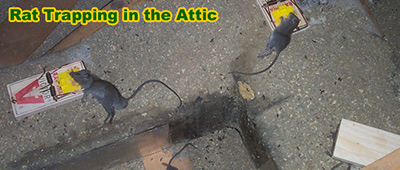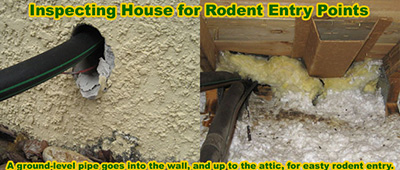Yes, many people don't like rats, but other people
understand that they intelligent animals, and have the same
relative emotions, ability to feel pain, etc as other
animals, such as pet cats or dogs, for example. If you are
sensitive to killing rats and want a humane alternative, it
is possible.
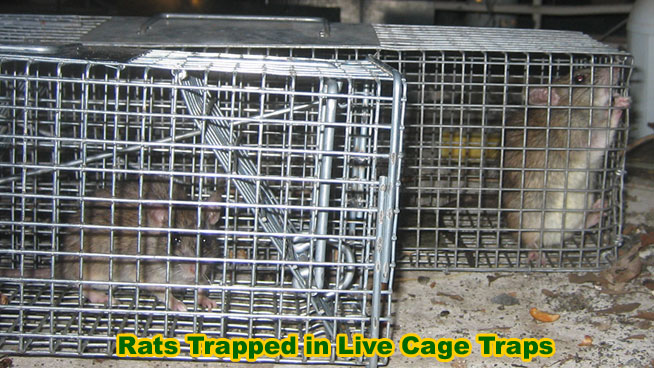
You can use cage traps instead of snap traps, or worse, glue traps, or even worse, poison. You can use exclusion instead of trapping at all. And you can engage in Rat Prevention, so you don't have to even worry about it. I'll analyze a couple of the options below:
EXCLUSION WITH ONE-WAY DOORS
You may be able to solve a rat problem without even using any traps at all. If you can successfully find out how the rats are getting in and out of the building, and seal off all but ONE popular entry/exit hole, you can set a one-way exclusion funnel or door on that hole. Rats are less likely to push their way out of a spring-loaded one-way door, but a funnel cone, made out of steel mesh, to just the right size, can do the trick.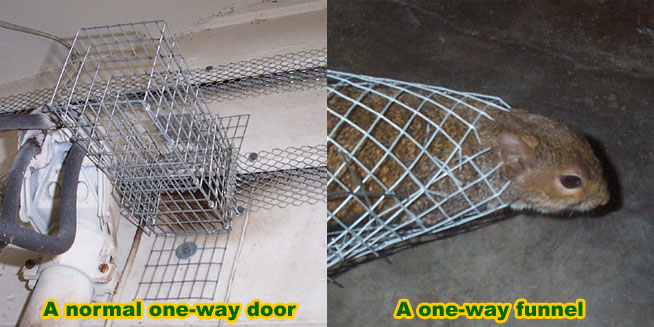
In the left picture, we see a normal one-way door set on a rat hole. Notice the dark brown staining on this hole - rats often leave thick brown smudges from fur grease if they go over a spot again and again. As stated, this type of door doesn't work perfectly with rats. Some are simply too timid to push open the spring loaded door. I've done several tests, and some rats will go through and some won't. But on the right, we see a funnel door (yes, that's a squirrel going through it, I don't have any photos of rats going through this type of device). Rats will usually go through this type of one-way door. But it must be made and set just right. The exit hole has to be the right size to go out, but not back in, which can be a little tricky given that rat sizes vary with age. And some rats are too timid to go through. But set right, it can work.
CAGE TRAPS
Yes, if you want to, you can use live cage traps, and trap them live, and let them go outside. This is possible. And I do very much like to be humane to animals, and rats have feelings too. But I do not use cage traps for rat control, and here are several reasons why:- The cages often don't fit in the little nooks and crannies that rats inhabit. Often, I'm wedging a trap in a small area, and a cage just won't fit.
- It's important to set many traps, at least a dozen at one time, to do the job right. Setting just one or two traps will cause several problems, because you'll have a bunch of free-agent rats with no trap to go to, and they start to gnaw and create problems. Not many people have access to a dozen cage traps.
- Cage traps are simply far less effective. Rats are cautious, and not as likely to walk into a cage trap and back to the bait trigger pan. With a snap trap, they simply run along their usual route, and WHAM, they're dead instantly. Or if it's the bait they are after, one tiny sniff, and SNAP. With the cage traps, they have to commit much more, and rats are super cautious.
- If you want to be humane, this is important - the traps MUST be checked every 8 hours or so. Rats can die quickly from heat stroke in an attic, and the stress of being in a cage trap can speed up dehydration and such. Most people who set cage traps in an attic don't have the discipline to check the traps on a frequent basis. You can negate some of the chance of death if you put fresh orange slices (a source of water) in the traps.
- Okay, say you do trap the rat in a cage, and let it go outside. It want to get back in the attic, and will sniff its way back and try to chew its way back in. If you've sealed the house properly, with steel, this should not be a concern, but still, you've got attic-acclimated rats out in the environment now. Relocating them a far distance, at least a few miles, helps.
- But the final thing - it's kind of pointless. Rats that are dislocated from the only home they know, where they have proven food and shelter, will almost certainly die very soon, from starvation, competition from other rats, and predators. It's not like there's some great rat shangri-la out there that you can take them to where they'll live on, happily. All your efforts of live trapping and relocation are in vain, because they're just going into an unsurvivable environment. If you demand to cage trap, you can read about What is the best bait to trap a rat?
WHAT IS MY PERSONAL CHOICE?
I use lethal snap traps. The above two methods don't always work perfectly, and often result in more suffering for rat. Cage traps have a variety of problems and impracticalities as discussed above, and rats, unfortunately, just don't respond 100% perfectly to one-way exclusion funnels. They tend to work better on squirrels. I want to solve the problem for my clients as well as I can. Rat control is already so difficult, that I can't bother with impractical methods. I am comfortable with my approach, and I always take animal welfare into consideration.Animal Lovers (like me)Take Note: If you catch rats alive and relocate them outside, or if you block them out of the attic, studies have proven that without their normal home and shelter, they die or fall to predators very quickly. Thus, trying to get rats out of the attic alive is pointless. I believe this is important to know. - David Seeveld
WHAT IS THE LIFE OF A RAT WORTH?
I fully believe that rats are intelligent animals that can feel pain and even emotions. However, not all mammals are equal. I guess, ultimately, I have to admit that I consider the life of a rat worth less than other animals. I know many people would disagree, but look at these facts:- Rats breed incredibly quickly. They can have 6 litters per year, with 8 rats per litter. They are sexually mature at THREE MONTHS OLD. I can't remember the exact math, but a breeding pair can create, by exponential growth, like 12,837,835,290 rats in three weeks' time. Okay, I'm kidding, but it's not like rats are rare.
- Rats rarely live more than a year anyway. Most die out very quickly. If you kill a rat, the chances are about 50% that it was going to die by some other means within 30 days. If you save a rat's life, the chances are about 50% that it is going to die by some other means within 30 days.
- They cause problems - that's why people want to get rid of them. That's also the reason many people don't like rats. I don't think they're vermin to be hated, the way other people do - in fact, I know that they are intelligent animals, and I actually believe that they have emotions. But they are problem animals.
Oh, and one other thing - my method of lethal rat control is the most humane available - I seal up the house right away, and only a few rats have to die, with instantaneous snap trap death, rather than a shitty pest control company that leaves the entry points open, and poisons rat after rat, month after month, letting them die slow, painful deaths.
Read more articles about rats:
What are the types of rat snap traps?
How to Make a Rat Trap
Is it legal for me to trap a rat?
Humane rat traps
THE SAME APPLIES TO MICE
Although I wrote this site with rats in mind, such as the Roof Rat and Norway Rat, the same principles apply to other rodents, such as the house mouse. Mice behave very similarly to rats, they're just smaller. Email me if you have any questions about how to live trap a mouse, humane mouse trapping, etc. There are some interesting live-mouse traps on the market, that don't exist for rats.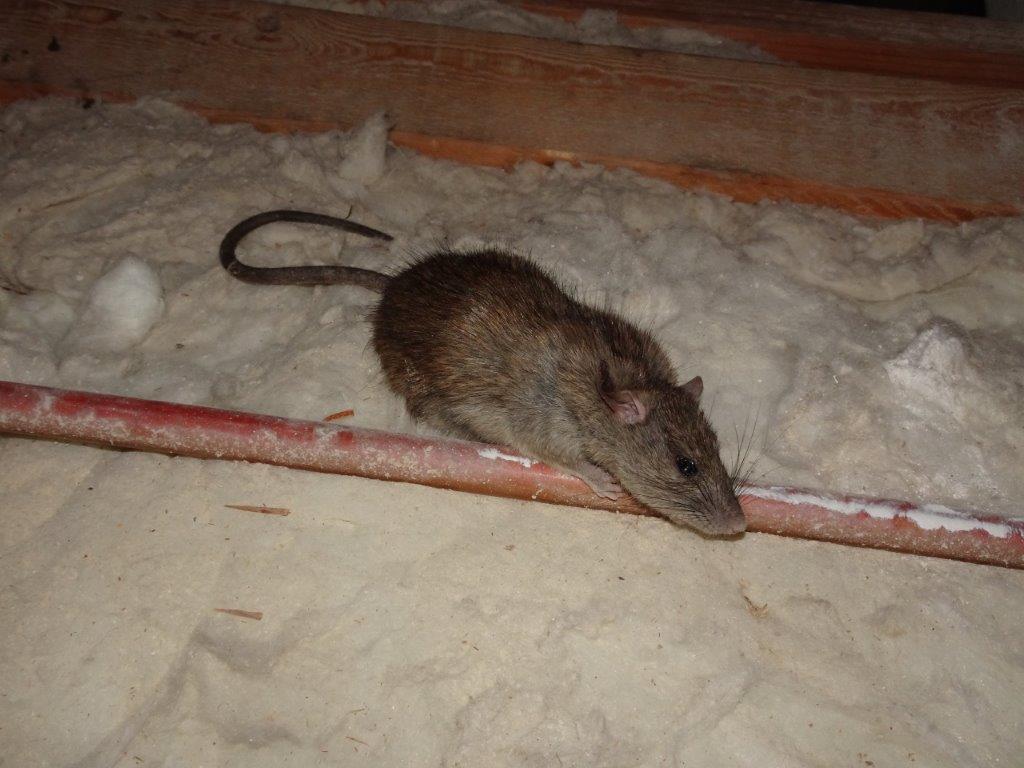
If you have a rat problem in your home it is likely that you have done some research, you’re here reading this after all, and have discovered that “humanely releasing the rat” can often lead the relocated rat to suffer a slow and agonizing death from exposure and starvation. Maybe it will be one of the lucky ones that are killed quickly by a predator.
This means that any rat you catch you need to kill quickly, painlessly, and therefore humanely. Before we start discussing the best method to kill a rat, you need to make sure that you have prevented any further rats from entering your home.
Traps
Very often the best method is to use a trap that kills instantly, leaving you with only having to dispose of the remains and clean up after. Many people for this reason stick to the old-fashioned wooden snap trap and consider this the most effective option.
The snap trap, believe it or not, has been around for hundreds of years with its design unchanged. This is because, despite years of technological advancements, this style of trap has been shown to be the most effective. In addition to their foolproof design, the versatility of this trap is what makes it so accessible for millions of people worldwide, being able to be set on walkways, holes, and on insulation.
Glue traps are not recommended as the way they work just ensures that the rat is stuck to the pad with the effectiveness of this trap depending on the size of the rat. Larger rats will simply chew off a leg or paw attached and continue doing the rat things it was doing before it was greatly inconvenienced. If a smaller rat or a bigger rat is trapped and held in place, it dies an agonizingly slow death in the most inhumane way.
Cage traps more often than not, use bait and a pressure-sensitive pad that springs the cage door close immediately after a rat steps on the pad. This doesn’t kill the rat unless it is not checked and the trapped rat is left to starve to death in an agonizing fashion. Rats are, by nature, fearful and cautious, meaning that unless no other option exists, a rat is unlikely to enter a closed structure, making these the least effective of all traps. Should you now have a live rat, you will need to exterminate it yourself or contact, and potentially pay for, a professional pest remover who will do this for you.
Shooting or clubbing
If you’re finding you have a live rat trapped and now you have to act deliberately to cause the death of this animal, you want to act quickly and humanely to prevent further suffering. The two easiest ways of doing this are either shooting or clubbing.
First, we will deal with shooting. The best method for this is with a powerful air rifle chambered for .22 or .177 and firing point black at the head of the rat, causing instantaneous death. Using anything more powerful than this will be severe overkill and will place others and yourself at risk of being injured or killed by a ricochet. Again anything that shoots slower than 1000 feet per second is not going to be powerful enough to get the job done.
Next, is clubbing. This can be done by aiming a strong and swift blow directly to the head of the rat, again causing instant death. The best tools for this are small bats or hammers that will carry a little weight with them. Please also remember to avoid touching and handling the rat directly and ensure that as soon as the rat is dead, deep clean the area around this.


